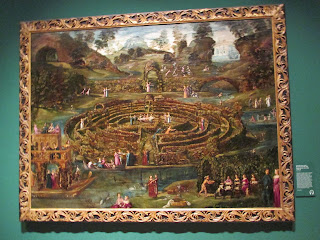The Royal Mews riding school, or Riding House, was built for George III. It was constructed under the direction of Sire William Chambers and was completed in 1765 - 1766. The Riding School is the focal point for the training of young horses, which are schooled by the Rough Riders and the Head Coachman.
The horse pictured above is named Lexington, he was just one of the few horses on display for visitors. To the right were some of the Royal Mews riders taking the grey horses out for training and exercised.
The Diamond Jubilee State Coach is the newest coach in the Royal Mews. It was created for Queen Elizabeth II to commemorate her Diamond Jubilee and was conceived and built in Australia by a team led by Mr. J. Frecklington, a former employee at the Royal Mews. The coach is postillion driven, with the groom on the pair of horses, and is almost five and a half meters long, over three meters high, and weighs over three tons.
On June 2, 1953, the Gold State Coach was used for the Coronation of Queen Elizabeth II. Not all of the monarchs enjoyed riding in the Gold State Coach, and many alterations have been made to it over the last 200 years. William IV compared it to traveling in a rough ship at sea, and Queen Victoria refused to ride in it due to its 'distressing oscillations'. In 1977 the entire coach was re-glided and the interior was partly re-upholstered using twenty meters of specialty woven and dyed fabric, as part of the refurbishment works for the Queen's Silver Jubilee.
Here is our wonderful tour guide Alan Lion. He provided a vast knowledge and insight of the Royal Mews and even hung around after the tour to answer some of our group members questions.
Our next stop was to the Queens Gallery, where many items of the Queens collection are on display.

In the late fifteenth century a new concept of the garden began to emerge in Renaissance Europe. Based old ideas of a classical garden, the way of organizing plant material was now governed by a formal, geometric approach, and ornament in the garden was enriched by the re-introduction of a range of forms from antiquity. Fantasy and reality were closely linked in the Renaissance garden and Italy was the crucible for the theatrical and inspiring new effects which were eagerly sought after in garden throughout Europe.
The tapestry to the left is known as Boys among apple trees. It is made out of woven silk and wool. The subject of winged putti or boys playing in apple trees or vines trained on pergolas appeared frequently in tapestries. This is one of a four-part series of The Playing Boys woven in England at the Mortlake tapestry works in the mid-seventeenth century.
The artwork above and to the right were just some of the pieces on exhibition.
 To the right, the group stopped for a quick photo in front of Kensington Palace. We later would be able to tour the inside of the palace.
To the right, the group stopped for a quick photo in front of Kensington Palace. We later would be able to tour the inside of the palace.
Kensington Palace is a royal residence set in Kensington Gardens, in the Royal Borough of Kensington and Chelsea in London, England. It has been a residence of the British Royal Family since the 17th century, and is the official London residence of the Duke and Duchess of Cambridge, Prince Harry, the Duke and Duchess of Gloucester, the Duke and Duchess of Kent, and Prince and Princess Michael of Kent. Today, the State Rooms are open to the public and managed by the independent charity Historic Royal Palaces, a nonprofit organization that does not receive public funds.
 Baily is seen here posing in front of a victorian jacket. Lilly and Sami are seen dressed up in old victorian clothing as well.
Baily is seen here posing in front of a victorian jacket. Lilly and Sami are seen dressed up in old victorian clothing as well. 
Sara is seen posing behind an old victorian dress and Michaela and Elizabeth are playing an old gambling game.
After Kensington Palace, we traveled to Westminster Abbey. West Minster Abbey was An architectural masterpiece of the 13th to 16th centuries, Westminster Abbey also presents a unique pageant of British history – the shrine of St Edward the Confessor, the tombs of kings and queens, and countless memorials to the famous and the great. It has been the setting for every Coronation since 1066 and for numerous other royal occasions, including sixteen royal weddings.
Today it is still a church dedicated to regular worship and to the celebration of great events in the life of the nation. It is neither a cathedral nor a parish church, Westminster Abbey (or the Collegiate Church of St Peter, Westminster to give it its correct title) is a "Royal Peculiar" under the jurisdiction of a Dean and Chapter, subject only to the Sovereign and not to any archbishop or bishop.


Westminster Abbey, a work of architectural genius, a place of daily worship, deploying the resources of high musical expertise, a burial place of kings, statesmen, poets, scientists, warriors and musicians, is the result of a process of development across the centuries, which represents the response of a monastery and later a post-Reformation church to the stimulus and challenge of its environment.












No comments:
Post a Comment